
USS New Orleans (LPD-18), a San Antonio-class amphibious transport dock, is the fourth commissioned ship of the United States Navy to be named after the city of New Orleans, Louisiana.
RIMPAC, the Rim of the Pacific Exercise, is the world's largest international maritime warfare exercise. RIMPAC is held biennially during June and July of even-numbered years from Honolulu, Hawaii, with the exception of 2020 where it was held in August. It is hosted and administered by the United States Navy's Indo-Pacific Command, headquartered at Pearl Harbor, in conjunction with the Marine Corps, the Coast Guard, and Hawaii National Guard forces under the control of the Governor of Hawaii. The US invites military forces from the Pacific Rim and beyond to participate. With RIMPAC the United States Indo-Pacific Command seeks to enhance interoperability among Pacific Rim armed forces, as a means of promoting stability in the region to the benefit of all participating nations. It is described by the US Navy as a unique training opportunity that helps participants foster and sustain the cooperative relationships that are critical to ensuring the safety of sea lanes and security on the world's oceans.
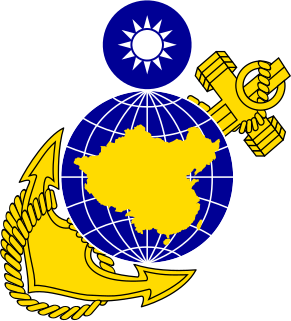
The Republic of China Marine Corps, also known colloquially as the Taiwan Marine Corps, is the amphibious arm of the Republic of China Navy (ROCN) responsible for amphibious combat, counter-landing and reinforcement of the areas under the jurisdiction of the Republic of China (Taiwan), including the island of Taiwan, Kinmen, and the Matsu Islands, and defense of ROCN facilities, also functioning as a rapid reaction force and a strategic reserve capable of amphibious assaults.

The People's Liberation Army Navy Marine Corps (PLANMC), also known as the People's Liberation Army Marine Corps (PLAMC), is the marine force of the People's Liberation Army (PLA) and one of five major branches of the PLA Navy (PLAN) responsible for amphibious warfare, expeditionary operations and rapid responses. It currently consists of six 6,000-man combined armed brigades and four other supporting brigades including aviation, engineering & chemical defense, artillery and service-support brigades. It further includes a brigade-level special operations unit called "Jiaolong Commando Unit"

The Bougainville campaign was a series of land and naval battles of the Pacific campaign of World War II between Allied forces and the Empire of Japan, named after the island of Bougainville. It was part of Operation Cartwheel, the Allied grand strategy in the South Pacific. The campaign took place in the Northern Solomons in two phases. The first phase, in which American troops landed and held the perimeter around the beachhead at Torokina, lasted from November 1943 through November 1944.

Marines, or naval infantry, are typically a military force trained to operate in littoral zones in support of naval operations. Historically, tasks undertaken by marines have included helping maintain discipline and order aboard the ship, the boarding of vessels during combat or capture of prize ships, and providing manpower for raiding ashore in support of the naval objectives. In most countries, the marines are an integral part of that state's navy.

Operation Chronicle was the Allied invasion of Woodlark and Kiriwina Islands, in the South West Pacific, during World War II. The operation was a subordinate action that formed part of the wider Operation Cartwheel, the advance towards Rabaul. An early planning name for this operation was Operation Coronet. Preliminary actions commenced on 23–24 June 1943 when small reconnaissance parties were landed on both islands. The main operation was executed without opposition on 30 June 1943. Around 16,800 personnel took part, divided into two forces. The United States Army provided the majority of ground troops, which were supported by a United States Marine Corps defense battalion as well as U.S. and Australian aircraft and naval vessels.
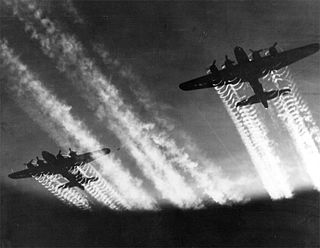
The military history of the United States in World War II covers the victorious American war against the Axis Powers, starting with the 7 December 1941 attack on Pearl Harbor. During the first two years of World War II, the United States had maintained formal neutrality as made official in the Quarantine Speech delivered by US President Franklin D. Roosevelt in 1937, while supplying Britain, the Soviet Union, and China with war materiel through the Lend-Lease Act which was signed into law on 11 March 1941, as well as deploying the US military to replace the British forces stationed in Iceland. Following the "Greer incident" Roosevelt publicly confirmed the "shoot on sight" order on 11 September 1941, effectively declaring naval war on Germany and Italy in the Battle of the Atlantic. In the Pacific Theater, there was unofficial early US combat activity such as the Flying Tigers.
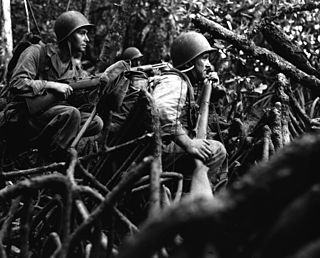
The Battle of Vella Lavella was fought from 15 August – 6 October 1943 between Japan and the Allied forces from New Zealand and the United States at the end of the New Georgia campaign. Vella Lavella, an island located in the Solomon Islands, had been occupied by Japanese forces early during the war in the Pacific. Following the fighting around Munda Point, the Allies recaptured the island in late 1943, following a decision to bypass a large concentration of Japanese troops on the island of Kolombangara.

The Battle of Arawe was fought between Allied and Japanese forces during the New Britain campaign of World War II. The battle formed part of the Allied Operation Cartwheel, and had the objective of serving as a diversion before a larger landing at Cape Gloucester in late December 1943. The Japanese military was expecting an Allied offensive in western New Britain, and was reinforcing the region at the time of the Allied landing in the Arawe area on 15 December 1943. The Allies secured Arawe after about a month of intermittent fighting with the outnumbered Japanese force.

The Landings at Cape Torokina, also known as Operation Cherryblossom, took place at the beginning of the Bougainville campaign in World War II. The amphibious landings were carried out by elements of the United States Marine Corps in November 1943 on Bougainville Island in the South Pacific, as part of Allied efforts to advance towards the main Japanese base around Rabaul under Operation Cartwheel. Coming in the wake of Allied successes at Guadalcanal and in the central Solomons, the landings were intended to secure a beachhead with the purpose of establishing several bases from which to project air and naval power closer towards Rabaul, in an effort to neutralize the large Japanese force that had been established there.

The Landings on Rendova were amphibious military assaults by United States Army, Marine Corps and Navy forces on Rendova Island in the Solomon Islands on 30 June 1943. The small Japanese garrison was quickly overwhelmed by US troops, but the island was subjected to heavy attack by Japanese aircraft over several days. The landings were some of the first Allied landings during the New Georgia Campaign of the Pacific War and were successful in securing the island and providing a base from which the Allies could support the subsequent invasion of New Georgia island and the eventual capture of Munda airfield in early August 1943.
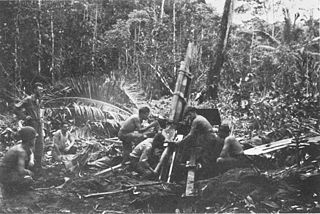
The Battle of Wickham Anchorage took place during the New Georgia campaign in the Solomon Islands during the Pacific War from 30 June – 3 July 1943. During the operation US Marines and US Army troops landed by ship around Oleana Bay on Vangunu Island and advanced overland towards the anchorage where they attacked a garrison of Imperial Japanese Navy and Army troops. The purpose of the attack by the U.S. was to secure the lines of communication and supply between Allied forces involved in the New Georgia campaign and Allied bases in the southern Solomons. The U.S. forces were successful in driving the Japanese garrison from the area and securing the anchorage, which would later be used to stage landing craft for subsequent operations.
The Fleet Landing Exercises, or FLEX were amphibious landing exercises conducted by the United States Navy and United States Marine Corps between 1935 and 1941. The purpose of these exercises was to formulate a workable amphibious warfare doctrine. The development of the necessary craft and other equipment, and the proper tactical deployment of them were also results. Finally, the exercises demonstrated the usefulness of a standing body of Marines, the Fleet Marine Force, specially prepared for amphibious expeditions.

Naval Patrolmen Branch is a branch of the Sri Lanka Navy that performs the role of naval infantry. Effectively members of this branch are soldiers of the navy. Originally limited for base and harbour security, in recent years Naval Patrolmen have taken part in offensive and defensive operations against the LTTE in conjunction with the Sri Lanka Army or independently, using both infantry and light armored units. It has also taken part in amphibious operations.
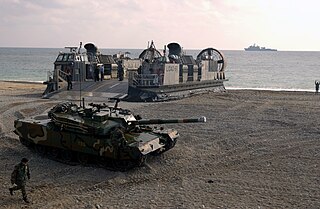
Foal Eagle is a combined field training exercise (FTX) conducted annually by the Republic of Korea Armed Forces and the United States Armed Forces under the auspices of the Combined Forces Command. It is one of the largest military exercises conducted annually in the world. Foal Eagle has been a source of friction with the government of Democratic People's Republic of Korea (DPRK) and domestic ROK critics.
The Amphibious Marine Brigade, also known as Amphibious Commando, is the marine corps unit of the Turkish Naval Forces based in Foça near İzmir, three amphibious battalions, an MBT battalion, an artillery battalion, a support battalion and other company-sized units.

The Han Kuang Exercise is the annual military exercise of the Republic of China Armed Forces in Taiwan, Penghu, Kinmen and Matsu for combat readiness in the event of an attack from the People's Liberation Army of the People's Republic of China.
Military exercises are conducted by the Pakistan Armed Forces to increase combat readiness, and to identify problems in logistics, training, and current military doctrine. They also test the ability of units to work together. Lastly, they act as a visible expression of military might, which acts as a deterrent to potential enemy action. An important component of each exercise is the after-action assessment. Since 1989 the four branches services have increasingly begun coordinated exercises.

The Amphibious Rapid Deployment Brigade is a marine unit of the Japan Self-Defense Forces (JSDF) responsible for conducting amphibious operations. It incorporates the former Western Army Infantry Regiment, which was the dedicated amphibious warfare unit of the Japan Ground Self-Defense Force.

















